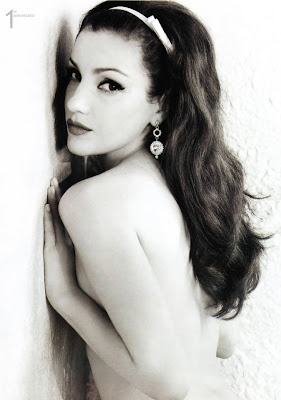Sea-Deep for My Tomorrow
1:59 PM
anjal
Here I sit and think,
The conscious hand draws deep into a shifting well
And thrusting forth into the amber glow of mind
Through the dark robe of shivering night
Into the air of sweet censers burning
Out of some antenatal dream
A vision turning and languid in the golden light
Like some Sybaritic dancer flowing forth
In a refulgent efflorescence
That foaming and shimmering for a brief moment
Vanishes back into the smooth plenum
Of the everyday.
When we were young
In fields we ran across to a ruined palace-wall
While rolling clouds bloomed in the exuberant air.
Do you remember the shadows that danced in the breezy dome of groves
As colors played across your lips
And voices fanned the wind with a splendid ovation ?
In the stream, by the wood
Alone I stood.
As winter consumed the green feast of spring
Till black skeleton trees stood still and silent
In a shivering bone-orchard against a pale sky.
When we were young
And thoughts did wander.
We gathered in dale near brook
To sing and sip from the voluptuous
Abundance of our invincible youth
And unpractis'd hands fumbled to
Discover the soft contours of Eros' face.
For a moment I stand amidst these wind-scattered leaves,
These memories .
The lustrous passions that bloom and wither
In fields where flowers fade.
And with these words I consecrate the contents of my almoners pension.
Now pushed out on a floating pyre to sink once again into yesterday
They are buried sea-deep for my tomorrow.
Rex Nemorensis
Puvis de Chavannes
9:06 AM
anjal
Puvis de Chavannes, Young Girls at the Seaside, 1879
Puvis de Chavannes, Hope, 1872
I have deigned the forthcoming month as "Symbolist Revival Month"
1:15 PM
anjal
Georges de Feure, The Voice of Evil, 1895
Symbolism was largely a reaction against Naturalism and Realism, anti-idealistic movements which attempted to capture reality in its gritty particularity, and to elevate the humble and the ordinary over the ideal. These movements invited a reaction in favour of spirituality, the imagination, and dreams; the path to Symbolism begins with that reaction. Some writers, such as Joris-Karl Huysmans, began as naturalists before moving in the direction of Symbolism; for Huysmans, this change reflected his awakening interest in religion and spirituality.
In literature, the movement has its roots in Les Fleurs du mal (The Flowers of Evil, 1857) by Charles Baudelaire. The aesthetic was developed by Stéphane Mallarmé and Paul Verlaine during the 1860s and '70s. In the 1880s, the esthetic was articulated through a series of manifestoes and attracted a generation of writers. The works of Edgar Allan Poe, which Baudelaire greatly admired and translated into French, were a significant influence and the source of many stock tropes and images. Distinct from the movement in literature, Symbolism in art represents an outgrowth of the darker, gothic, side of Romanticism; but where Romanticism was impetuous and rebellious, Symbolist art was static and hieratic.
Ferdinand Hodler, Night, 1890
The Symbolist Manifesto
Symbolists believed that art should aim to capture more absolute truths which could only be accessed by indirect methods. Thus, they wrote in a highly metaphorical and suggestive manner, endowing particular images or objects with symbolic meaning. The Symbolist manifesto ("Le Symbolisme", Le Figaro, 18 Sept 1886) was published in 1886 by Jean Moréas. Moréas announced that Symbolism was hostile to "plain meanings, declamations, false sentimentality and matter-of-fact description," and that its goal instead was to "clothe the Ideal in a perceptible form" whose "goal was not in itself, but whose sole purpose was to express the Ideal":
Ainsi, dans cet art, les tableaux de la nature, les actions des humains, tous les phénomènes concrets ne sauraient se manifester eux-mêmes ; ce sont là des apparences sensibles destinées à représenter leurs affinités ésotériques avec des Idées primordiales.
(In this art, scenes from nature, human activities, and all other real world phenomena will not be described for their own sake; here, they are perceptible surfaces created to represent their esoteric affinities with the primordial Ideals.)
Néstor, Poem of the Atlantic, 1917
The Century of the Self
7:20 PM
anjal
The Century of the Self asks deep questions about the roots and methods of modern consumerism, representative democracy and its implications. It also questions the modern way we see ourselves, the attitude to fashion and superficiality.
The business and, increasingly, the political world uses PR to read and fulfill our desires, to make their products or speeches as pleasing as possible to us. Curtis raises the question of the intentions and roots of this fact. Where once the political process was about engaging people's rational, conscious minds, as well as facilitating their needs as a society, the documentary shows how by employing the tactics of psychoanalysis, politicians appeal to irrational, primitive impulses that have little apparent bearing on issues outside of the narrow self-interest of a consumer population. He cites a Wall Street banker as saying "We must shift America from a needs- to a desires-culture. People must be trained to desire, to want new things, even before the old have been entirely consumed. [...] Man's desires must overshadow his needs."
If you only have time to watch one, make it part 3
part 2
part 3
part 4
part 2
part 3
part 4





















-03.jpg)

-07.jpg)


-04.jpg)

-06.jpg)













